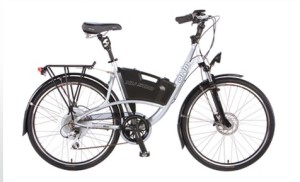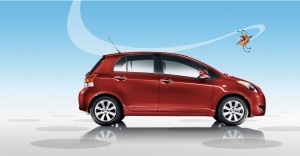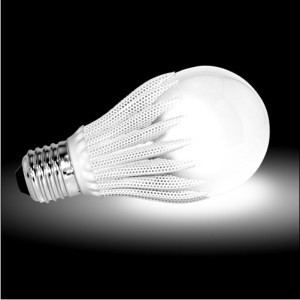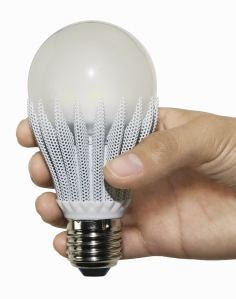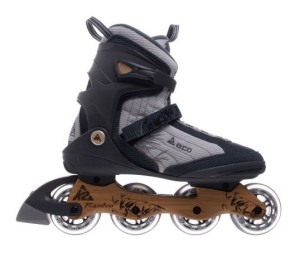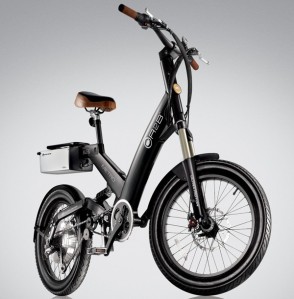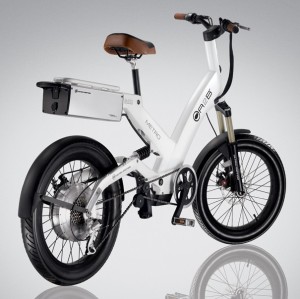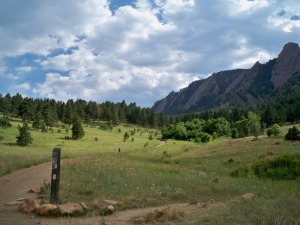 |
| Hiking path in Boulder Colorado (photo by Aaron Dalton) |
This just in - Colorado has mountains!
OK, it's not exactly the newsflash of the century, but I'm sure I'm not the only person who ever flew into Denver (where I'd spent my entire previous trip to Colorado) and wondered whether the distant outline on the horizon was in fact the Rocky Mountain range.
Well, after spending a week in northern Colorado bouncing around between Boulder, Fort Collins, Estes Park and the Rocky Mountain National Park, I can in fact report that the mountains do exist.
(Although truth be told they look remarkably similar up close to the fake mountains at the Disney theme parks, especially the Big Thunder Mountain ride. I kept expecting a theme park coaster full of screaming kids to materialize from behind an escarpment at any moment. Nonetheless, despite the resemblance, I'm prepared to believe that the Rocky Mountains are not just a creation of Uncle Walt.)
And now, with apologies for such extensive throat clearing, I present a few nuggets (pun intended) of information on eco travel in northern Colorado.
Boulder - The Denver Post has described Boulder as a "little town nestled between the mountains and reality."
It's true. Boulder is very close to the mountains - and it is a bit separate from reality. There's a certain vibe here as though the 60's never ended. Strolling around the pedestrian-only Pearl Street Mall on a Thursday afternoon, my wife and I encountered a sizeable crowd sitting in the shade and listening to a duo of folk singers. I don't think I had smelled so much incense in the air since graduating college.
Later that night, in the courtyard of the sophisticated yet comfortable St. Julien Hotel & Spa, a much larger crowd rocked out in unpretentious glee to the upbeat sounds of a Brazilian band, while women and children hula-hooped on a grassy lawn.
Here's the best way I can sum up my experience in Boulder. When the valet at the St. Julien found out I was writing a story on the place, he told me how much he loved the town for its "gentle" vibe. I've never heard anyone else describe their town as gentle, but it really does seem to fit Boulder.
Anyway, back to the St. Julien. With its in-room recycling bins, its use of low-VOC materials (carpets, paints and wall coverings), its use of earth-friendly cleaning products and its decision to avoid any leather products, the St. Julien has a long list of eco-friendly qualities. The hotel's restaurant - Jill's - not only serves a seriously delicious buffet lunch (salads, pizzas, sandwiches, soup, fresh bread, etc.), it does so while sourcing as much organic produce and humanely-farmed livestock as possible, composting its food waste and recycling its cooking oil for the creation of biodiesel. The hotel recently planted an on-property herb garden to make sure Jill's had plenty of locally-grown ingredients for its recipes. Some of these same herbs are then incorporated into the St. Julien's spa treatments. Expect to pay approximately $240-260/night for a room at the St. Julien this fall.
 |
| Prickly pear flower in Boulder Colorado's Chautauqua area (photo by Aaron Dalton) |
We took advantage of another eco-friendly perk at the St. Julien -- free use of cruiser bikes for hotel guests. The cheery bikes look cute and retro, but the lack of hand brakes may frustrate some riders. That grumble aside, the hotel is practically across the street from an entrance to one of Boulder's nicest bike paths that threads alongside Boulder Creek.
The St. Julien also sits close by the Chautauqua Park area, part of more than 45,000 acres of open space land owned by the city of Boulder and managed by the department of Open Space and Mountain Parks. The Chautauqua area is not only convenient to downtown, it contains a variety of trails leading right up to the famous Flatirons rock formations that serve as beautiful backdrop to the town.
You'll frequently see Boulder appear at the top of city lists for its livability and healthy environment. For example, the town attracts a wealth of athletes who come to train in its sunny, high-altitude environment. But it's the community that really makes Boulder special. The city is proud of its claim to be the first city in the U.S. to tax itself for the acquisition, management and maintenance of open space back in 1967. The city's residential green building code dates to 1996 - another first.
That community has attracted the type of people who own Green companies including Namasté Solar, IZZE sparkling juice, Pangea Organics (previously reviewed on 1GreenProduct.com), Horizon Organic, Fiona's Granola and Ellie's Eco Home Store.
The city is considered to be a fine-dining destination. We didn't spend enough time in town to confirm or deny that reputation, but I will say that chef Eric Skokan's Black Cat Farm Table Bistro cooks up some awesome organic and local dishes. I was particularly impressed with the beet salad (sliced paper thin) and the cucumber soup (refreshing and clarifying on a warm evening). Service was warm, friendly and informal - par for the course in Boulder.
In short, it's a bit silly trying to describe everything that's eco about Boulder. Let's just say that Green-minded folks will breathe deeply of the clean mountain air and feel instantly at home. For plenty more Green info on Boulder, visit the Environment page of the Boulder CVB.
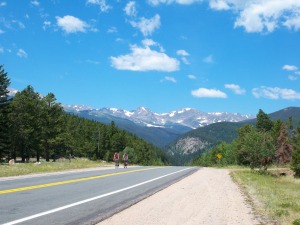 |
| Amazing cyclists on the beautiful Peak to Peak Byway - the roundabout route between Boulder and Fort Collins (photo by Aaron Dalton) |
Fort Collins - This college town (home to Colorado State University) has a great reputation. Among the many awards won by the city, residents seem fairly proud of the 2006 designation by Money Magazine, which called Fort Collins the best place to live in the U.S.A.
More recently, the Natural Resources Defense Council placed Fort Collins #3 on a list of 'Smarter Cities' based on environmental standards including use of renewable energy, creation of green space, encouragement of alternative transportation and energy-efficient building techniques.
Speaking of alternative transportation, the 280+ miles of bike lanes and 30+ miles of bike paths have helped Fort Collins achieve a Gold level designation as a Bicycle Friendly Community. Recently, the city installed new bike racks downtown with the help of New Belgium Brewery, a local institution praised as much for its eco-sensibility as for its awesome microbrews.
Visitors to Fort Collins can take a tour (and tasting) at New Belgium, learning why the brewery's signature beer is called Fat Tire and about the important role bikes play in the company's culture.
I have a lot of respect for companies and communities that are willing to put their money on the line alongside their Green sensibilities. Just as the citizens of Boulder took a hit to their pocketbooks when they voted to tax themselves to preserve Green space, so too did New Belgium's employees take an economically irrational decision back in 1999 when they voted unanimously to give up profit-sharing bonuses for 10 years in order to pay a premium for wind-powered electricity.
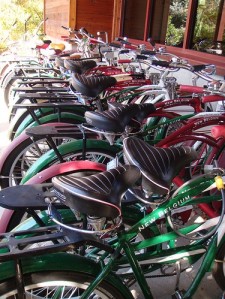 |
| Full bike rack outside New Belgium Brewery in Fort Collins, Colorado (photo by theregeneration via Flickr) |
New Belgium also has a sweet policy of giving employees a free cruiser bike on their one-year anniversary with the company.
Meanwhile, the company isn't slowing down on its efforts to become Greener by diverting more waste from landfills and planning installation of a solar photovoltaic array. Basically, I came away super-impressed by New Belgium's ability to turn challenges into beautiful eco-friendly solutions. Faced with the destruction of the state's beautiful lodgepole pine forests by beetle infestation, New Belgium decided to use some of the fallen dead trees to build its new packaging hall. When the company had to find a better way to treat wastewater from its brewing and packaging activities, it built its own treatment facility that captured methane gas and used it to power a co-gen plant that supplies up to 15% of the company's electrical needs.
And did I mention that the beer is pretty tasty? ;-)
Incidentally, Fort Collins also has other well-regarded microbreweries (Odell Brewing Company, Fort Collins Brewery and Coopersmith) and a massive Anheuser-Busch macrobrewery.
Fort Collins also has an ambitious project underway to create the world's largest zero-energy district. Called FortZED, this district encompasses the historic downtown and the main campus of CSU, aiming to reduce energy demand and simultaneously meet the remaining demand with Smart Grid technologies including wind and solar energy.
Colorado State University also plays a major role in Green research and development. The university's Engines and Energy Conversion Laboratory (EECL) looks for ways to make engines more efficient and investigates potentially useful biofuels like algae. If you happen to be visiting Fort Collins with a group of at least 7 other eco-minded friends, you may be able to organize a tour of EECL by contacting Stacy Grant at CSU.
While in Fort Collins, eco-minded visitors might like to sample the yummy organic/vegan fare at Tasty Harmony. I enjoyed the jackfruit taco and the awesome berry smoothie.
If you're looking for a little adventure, Mountain Whitewater Descents offers rafting trips on the Cache la Poudre river, Colorado's only Wild and Scenic River. I'd been rafting once before and had unintentionally gone swimming a couple of times on that previous trip, so I was a little anxious about the ride, but the Cache la Poudre trip actually turned out to be just the right mix of relaxing floating and adrenaline-pumping rapids. MWD's prices range from $49 to $109 per person for half-day or full-day rafting trips. (Since the rafts are human-powered and go downstream with the current, the experience seems relatively benign and eco-friendly for the river. Of course, there are diesel-powered buses involved in bringing the rafts and people upstream to the put-in point, so the experience can't be classified as totally eco-friendly, but MWD does give back to the environment with an annual river cleanup, tree-planting to offset carbon emissions, purchases of wind-power credits (with a goal of being 100% wind-powered) and donations of 2% of gross receipts to non-profit organizations. The company also lives the recycling credo in its everyday life by re-using salvaged lumber and materials in its office and recreation areas.
 |
| Oreo - resident cat at the Armstrong Hotel - needs a bigger chair (photo by Aaron Dalton) |
If you'd rather park your car and spend your time walking and biking around Fort Collins, I'd suggest staying at the Armstrong Hotel, a 1923 landmark that was restored in 2004. With free wi-fi in every room, a great location and free cruiser bikes available to guests, the Armstrong was a great home base while in Fort Collins. Cat lovers take note -- lazy kitty Oreo seems to spend all day snoozing away in the chair next to the front desk and is perfectly happy to be petted whenever you like.
If you want to get out of town and enjoy nature, the city of Fort Collins does have a Natural Areas Program funded by citizen-initiated taxes and encompasing more than 32,000 acres of land suitable for hiking, biking, bird watching and horseback riding - most of which are open from early in the morning (5 a.m.) until late at night (11 p.m.).
Two other quick eco tidbits about Fort Collins. The city has a Climate Wise program to help businesses figure out ways to reduce waste, save energy, conserve water and promote alternative transportation. And in case you're not staying at the Armstrong, there's also a local Bike Library in Fort Collins where you can borrow a bike for up to 7 days at no cost.
Oh and in case you're in the market for a lithium-ion powered tricycle, I just read about a new electric bike shop called RunAbout Cycles that relocated to Fort Collins.
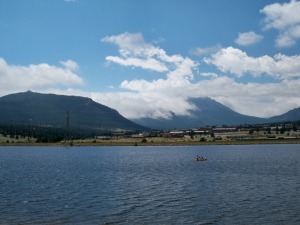 |
| Morning view across lake in Estes Park, Colorado (photo by Aaron Dalton) |
Estes Park - Estes Park is one of the gateway towns for Rocky Mountain National Park, which gives eco-minded travelers more than a quarter million acres of rugged land with almost 360 miles of trails, 150 lakes and more streams, vistas and wildlife than you can shake a stick at.
If you're looking for non-motorized ways of exploring the beautiful countryside around Estes Park, consider a horseback ride from Aspen Lodge or an exhilirating downhill bicycle tour with Colorado Bicycling Adventures.
(Be sure to wear warm clothes on the cycling tour. I was freezing in just a t-shirt in the middle of July. I also was happy that I'd taken the relatively gentle North Fork tour rather than the windswept, high-altitude Trail Ridge Tour. Plus the North Fork riders get to enjoy the awesomely delicious cinnamon rolls from the Glen Haven General Store.)
If you're looking for a good meal in Estes Park, consider the Rock Inn, which we found to have a comfortably casual atmosphere, welcoming service and even some organic ingredients on the menu (coffee, tea, apples, quinoa, etc.). You might also enjoy the unbeatable lakeside view in the Shores Restaurant at the Lake Shore Lodge hotel.
The clear mountain air and high elevation make Estes Park a lovely place for star-gazing. Amateur astronomers will get a thrill out of visiting the newly-opened Estes Park Memorial Observatory with its 16-ft. diameter observatory dome, its Meade 12-inch LX200 Schmidt-Cassegrain telescope and its gracious staff. The observatory has two open houses scheduled for August (15th and 29th), but I believe you can make appointments to visit on your own at other times by emailing the observatory directly.
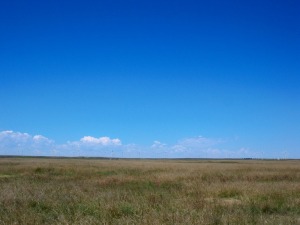 |
| Timeless shortgrass prairie and modern wind farm practically invisible on the far horizon at the Pawnee National Grassland (photo by Aaron Dalton) |
Pawnee National Grassland - For most tourists, Colorado equals mountains for skiing, hiking or just sightseeing. But the fact is that much of the Eastern section of the state consists of high prairie. Most of this high prairie has been developed for farms, ranches or cities, but you can still see nearly 200,000 acres of the grassland in their native form at the Pawnee National Grassland.
This is definitely the road less traveled. Conditions can be extreme on the grasslands - very hot and dry in summer, dangerously cold and snowy in winter. But if you've got a hankering for wide open spaces and a desire to see something like the views that the first caucasian settlers must have seen as they crossed the plains, the grassland can't be beat.
As a bonus, the Grassland has a reputation as a world-class birding destination where bird enthusiasts come to see raptors, hawks, burrowing owls, thrashers, lark buntings, numerous kinds of sparrows and literally hundreds of other species of birds. Guides to the Pawnee National Grassland urge birders to do their birdwatching from the car so as not to disturb birds or scare them away from nests. Since the Grassland is actually a patchwork of private and public land, staying on the numbered roads is also essential. And since many of those roads are unpaved and not even graveled, be sure to check the weather reports since rains can apparently make many of the roads impassable.
 |
| Your intrepid editor hiking near the Pawnee Buttes on the Pawnee National Grassland |
If you come to the Grassland, make a point to seek out the Pawnee Buttes, remnants of an ancient landscape that has been mostly eroded away by the action of wind and water over millions of years. A hiking trail leads to the base of the Buttes - just be sure to watch your step to avoid cacti and prairie rattlers.
If you'd like to spend a night out on the grassland, you can try to get a room at the West Pawnee Ranch B&B. For more creature comforts, the most convenient urban base close to the Pawnee Grassland would be the city of Greeley, an interesting place in its own right that began in 1868 as a utopian agricultural colony founded by Nathan Meeker, agricultural editor of the New York Tribune. Meeker named the town after his editor at the Tribune, Horace Greeley, whose name has become inextricably linked with the 19th Century ralling cry, "Go West, young man, go West and grow up with the country."
Today, the country has certainly grown up and moved on. The countryside that Americans like Meeker, Greeley and others knew less than 150 years ago has mostly disappeared, but remnants like the Pawnee Grasslands endure and provide a glimpse back into another world.
Well...even the view isn't quite untouched. On the horizon, a line of bluffs marks a boundary with Wyoming and a wind farm atops the bluffs provides an inspiring clean energy sight. I think this might be the Ponnequin Wind Farm owned by Xcel Energy.
If your curiosity for the Pawnee National Grassland has been aroused, definitely check out these gorgeous photos of the Pawnee Buttes by Rick Dunn.
(I didn't get to spend as much time as I would have liked in Greeley, but the town seems to be home to some interesting cultural attractions including Kress Cinema & Lounge and The Greeley Philharmonic - oldest continually running orchestra between St. Louis and San Francisco!
Afterthoughts -
1. Prius - I had a chance to drive a Toyota Prius for the first time in Colorado - not the new 3rd-generation Prius but the second-generation version. I'll save a full review for when I get a chance to test drive the 3rd-generation car, but generally I was very impressed with the vehicle. Green Car Congress notes that the 1st generation Prius had a combined mileage rating of 41 mpg, the 2nd generation car had a mileage rating of 46 mpg, while the 3rd generation Prius has a combined mpg rating of 50 mpg.
Amazingly, even at high altitude and with lots of uphill mountainous driving (and of course lots of corresponding downhill rides), I managed to get over 50 mpg in the 2nd generation Prius. This gives me great home for achieving even better mileage in the 3rd generation car. I found the car's feedback system simultaneously exciting and annoying -- I liked knowing exactly what impact my driving habits were having on fuel efficiency, but I also found that it distracted me a bit from the road, the scenery and the pleasures of driving.
Still, in the end, 50+ mpg can't be beat. I loved driving around Colorado for a week and then topping up the tank for $16 and change.
2. Denver Airport Solar Array - On my way back into the airport to fly home to NYC, I noticed a large solar array on the approach to the airport. This is certainly the biggest airport solar installation I've ever seen and one of the biggest solar arrays I've witnessed firsthand. Information online indicates the array generates more than 3 million kWh of electricity, enough to provide half the energy for the underground train that connects the terminals at DIA.
I also noticed that some of the limited-access highways near Denver allow bicycling on the shoulder of the road. What do you think of that? Clever idea or recipe for disaster?
